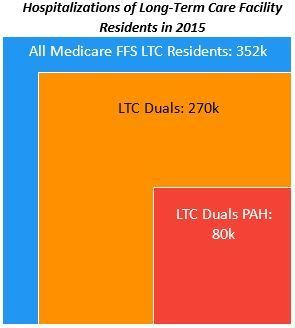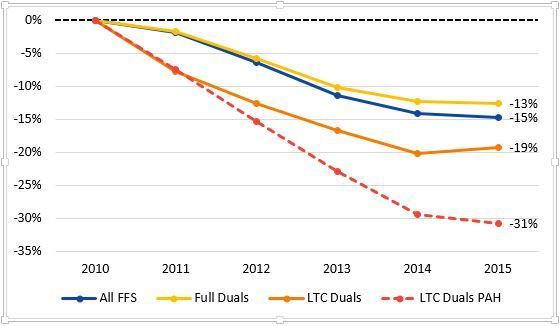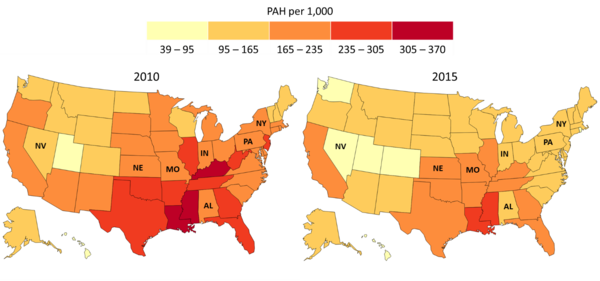|
January 17, 2017
By Niall Brennan, Director of the CMS Office of Enterprise Data and Analytics, and CMS Chief Data Officer; and, Tim Engelhardt, Director of the Federal Coordinated Health Care Office at CMS
Data Brief:
Sharp reduction in avoidable hospitalizations among long-term care facility
residents
For long-term care facility residents, avoidable
hospitalizations can be dangerous, disruptive, and disorienting. Keeping our
most vulnerable citizens healthy when they are residents of long-term care
facilities[1] and reducing potentially avoidable hospital stays has been a
point of emphasis for the Centers for Medicare & Medicaid Services (CMS).
Over the last several years, with the help from the Affordable
Care Act, Medicare and Medicaid have worked with other federal government
agencies, states, patient organizations, and others to identify and prevent
those health conditions that have caused long-term care residents to be
unnecessarily hospitalized. Because of these efforts, we have seen a dramatic
reduction in avoidable hospitalizations over the last several years,
according to below analysis released by CMS today.
In 2001, the Agency for Healthcare Research and Quality (AHRQ)
first identified a set of measures designed to identify hospitalizations that
could potentially be avoided with appropriate outpatient care. They include
hospital admissions for largely preventable or manageable conditions like
bacterial pneumonia, urinary tract infections, congestive heart failure,
dehydration, and chronic obstructive pulmonary disease. More recently, CMS’s
own Office of Enterprise Data and Analytics found that instances of these
potentially avoidable hospitalizations (PAH) were disproportionally high
among some of our nation’s most vulnerable people, those dually eligible for
Medicare and Medicaid living in long-term care facilities.
Treating conditions before hospitalization and preventing
these conditions whenever possible would not only help long-term care
facility residents stay healthy, but may also save Medicare and Medicaid money.
After carefully examining this problem, CMS and others focused on reducing
the instances of potentially avoidable hospitalizations from these
facilities.
 |
|
In
2015, Medicare fee-for-service (FFS) beneficiaries living in long-term care
facilities had a total of 352,000 hospitalizations. Of this number, Medicare
beneficiaries eligible for full Medicaid benefits living in long-term care
facilities (LTC Duals) accounted for 270,000 hospitalizations. And, almost a
third (approximately 80,000) of these hospitalizations were caused by six
potentially avoidable conditions: bacterial pneumonia, urinary tract
infections, congestive heart failure, dehydration, chronic obstructive
pulmonary disease or asthma, and skin ulcers.
Through
the concerted effort by CMS and many other to address these potentially
avoidable conditions, real progress has been made to improve the health and
wellbeing of some of our country’s most vulnerable citizens. In recent years,
the overall rate of hospitalizations declined by 13 percent for dually
eligible Medicare and Medicaid beneficiaries. But we have seen even larger
decreases in hospitalization rates for potentially avoidable conditions among
beneficiaries living in long-term care facilities. Specifically,
between 2010 and 2015, the hospitalization rate for the six potentially
avoidable conditions listed above decreased by 31 percent for Medicare and
Medicaid dually-eligible beneficiaries living in long-term care facilities.
In
2010, the rate of potentially avoidable hospitalizations for dually-eligible
beneficiaries in long term care facilities was 227 per 1,000 beneficiaries;
by 2015 the rate had decreased to 157 per 1,000.[1] This decrease in
potentially avoidable hospitalizations happened nationwide, with improvement
in all 50 states. The reduced rate of potentially avoidable hospitalizations
means that dually-eligible long-term care facility residents avoided 133,000
hospitalizations over the past five years.
Percent Change in
Medicare Hospitalization Rates Since 2010

Note: FFS (fee-for-service), LTC (long-term care
facility), PAH (potentially avoidable hospitalization)
Potentially Avoidable Hospitalization Rates for
Dual-Eligible Beneficiaries Living in Long-Term Care Facilities, by State

Note:
Labeled states contain facilities in the CMS “Initiative to reduce avoidable
hospitalizations among long-term care facility residents”, discussed below.
This
success would not be possible without the committed work by those who
directly serve older adults and people with disabilities. We also should
consider the range of other contributing factors, including:
This
success shows that a sustained commitment to smarter spending across the
entire health care system can yield dramatic results and improve the lives of
vulnerable Americans. These results are also consistent with other ongoing
collaborative efforts to improve the quality of care patients received
through preventing hospital-acquired conditions
where approximately 125,000 fewer patients died due to hospital-acquired
conditions and more than $28 billion in health care costs were saved from
2010 through 2015.
Finding
the best possible long-term care facility care for a loved one is one of the
most difficult decisions family members can make. Family members want to be
assured that their loved one will receive the highest quality of care in a
healthy environment. And thanks to efforts across the health care industry,
and with tools from the Affordable Care Act that allow CMS to improve quality
and test innovative strategies, these residents are living in safer,
healthier environments.
###
[1]
The seven sites were: Nevada, Nebraska, Montana, New York, Pennsylvania,
Indiana, and Alabama. Note that six of these sites have continued into “Phase
II” of the Initiative, which launched in October 2016.
[2]
For more information, see the Initiative website at: https://innovation.cms.gov/initiatives/rahnfr/
[3]
The seven sites were: Nevada, Nebraska, Montana, New York, Pennsylvania,
Indiana, and Alabama. Note that six of these sites have continued into “Phase
II” of the Initiative, which launched in October 2016.
[4]
For more information, see the Initiative website at: https://innovation.cms.gov/initiatives/rahnfr/
|

At Medicare is Simple, we look to educate and enable you to choose among Medicare plans to help find the policy that may best fit your needs. Get free quotes using our advanced quoting technology. HealthCare Reform is also a hot topic of interest to people of all ages, and we look to keep you updated on the issues relevant to learning more. Medicare Is Simple 800-442-4915
Tuesday, January 17, 2017
Sharp reduction in avoidable hospitalizations among long-term care facility residents
Subscribe to:
Post Comments (Atom)
No comments:
Post a Comment